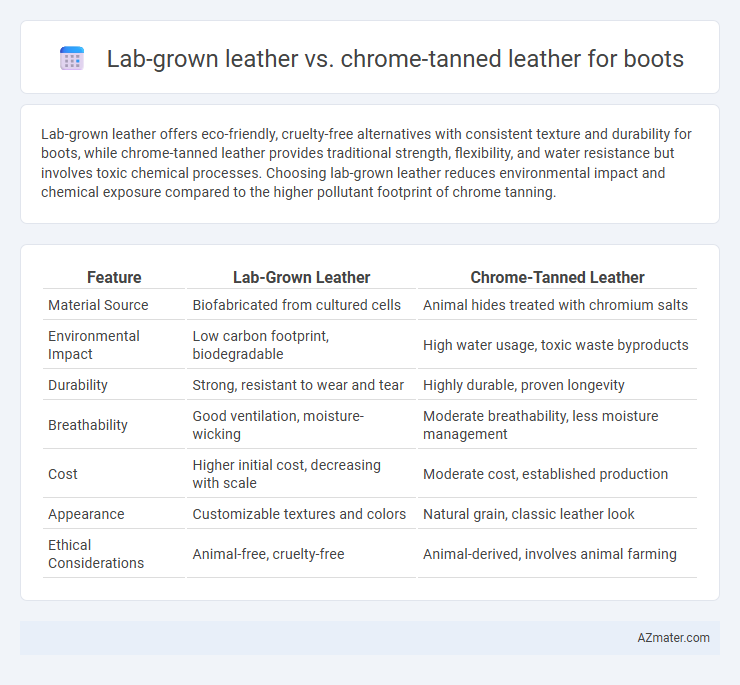Lab-grown leather offers eco-friendly, cruelty-free alternatives with consistent texture and durability for boots, while chrome-tanned leather provides traditional strength, flexibility, and water resistance but involves toxic chemical processes. Choosing lab-grown leather reduces environmental impact and chemical exposure compared to the higher pollutant footprint of chrome tanning.
Table of Comparison
| Feature | Lab-Grown Leather | Chrome-Tanned Leather |
|---|---|---|
| Material Source | Biofabricated from cultured cells | Animal hides treated with chromium salts |
| Environmental Impact | Low carbon footprint, biodegradable | High water usage, toxic waste byproducts |
| Durability | Strong, resistant to wear and tear | Highly durable, proven longevity |
| Breathability | Good ventilation, moisture-wicking | Moderate breathability, less moisture management |
| Cost | Higher initial cost, decreasing with scale | Moderate cost, established production |
| Appearance | Customizable textures and colors | Natural grain, classic leather look |
| Ethical Considerations | Animal-free, cruelty-free | Animal-derived, involves animal farming |
Introduction: The Evolution of Leather in Bootmaking
Lab-grown leather offers a sustainable alternative to traditional chrome-tanned leather in bootmaking by reducing environmental impact and chemical usage. Chrome-tanned leather, known for its durability and water resistance, relies on heavy metal salts like chromium, which pose ecological and health risks. The evolution in boot leather highlights a growing demand for eco-friendly materials without compromising strength and aesthetic appeal.
What is Lab-Grown Leather?
Lab-grown leather is a sustainable alternative created by culturing animal cells in a controlled environment, mimicking the natural growth of traditional leather without raising or slaughtering livestock. It offers benefits including reduced environmental impact, less chemical use compared to chrome-tanned leather, and customizable texture for high-quality boots. This innovative material supports ethical fashion while maintaining durability and aesthetics essential for premium footwear.
Understanding Chrome-Tanned Leather
Chrome-tanned leather for boots undergoes a chemical tanning process using chromium salts, which enhances durability, water resistance, and flexibility compared to traditional vegetable tanning. This method results in a plush texture and vibrant color retention, making chrome-tanned leather a popular choice for boots requiring long-lasting wear and comfort. However, concerns over environmental impact and chemical usage have driven interest in eco-friendly alternatives such as lab-grown leather.
Production Processes: Lab-Grown vs Chrome-Tanned
Lab-grown leather production involves biofabrication techniques where collagen proteins are cultured from animal cells in controlled environments, reducing environmental impact and chemical use. Chrome-tanned leather utilizes chromium salts to stabilize animal hides, a process that emits hazardous waste and consumes significant water and energy resources. The controlled conditions of lab-grown leather offer a sustainable alternative, while chrome tanning remains dominant for durability but poses ecological challenges.
Environmental Impact Comparison
Lab-grown leather significantly reduces environmental impact by eliminating harmful chemicals and decreasing water usage compared to chrome-tanned leather, which relies heavily on toxic chromium salts and generates hazardous waste. Chrome-tanned leather production contributes to soil and water pollution due to chemical runoff and requires substantial energy consumption, leading to higher carbon emissions. Choosing lab-grown leather for boots supports sustainable manufacturing practices by minimizing ecological damage and reducing the carbon footprint associated with traditional tanning processes.
Durability and Performance in Boots
Lab-grown leather offers high durability and consistent strength due to its controlled manufacturing process, making it resistant to cracking and stretching in boots. Chrome-tanned leather, widely used in traditional bootmaking, provides excellent water resistance and flexibility but may degrade faster under harsh conditions due to chemical tanning. Performance in boots shows lab-grown leather maintaining structural integrity longer, while chrome-tanned leather excels in breathability and natural feel, balancing comfort with durability.
Aesthetic Differences: Look and Feel
Lab-grown leather offers a consistent texture with a smooth, uniform surface that mimics genuine leather's natural grain while reducing imperfections commonly found in chrome-tanned leather. Chrome-tanned leather exhibits a rich patina that develops over time, providing a distinctive character and depth unique to each boot. The tactile feel of lab-grown leather tends to be softer and more pliable initially, whereas chrome-tanned leather feels firmer and gains suppleness with wear.
Ethical Considerations and Animal Welfare
Lab-grown leather offers a significant ethical advantage over chrome-tanned leather by eliminating the need for animal hides, thereby reducing animal suffering and the environmental impact associated with livestock farming. Chrome-tanned leather involves toxic chemicals that pose health risks to tannery workers and contribute to environmental pollution, whereas lab-grown leather utilizes sustainable, cruelty-free processes with minimal toxic byproducts. Choosing lab-grown leather for boots supports animal welfare and promotes a more responsible, eco-friendly fashion industry.
Cost and Market Availability
Lab-grown leather offers a competitive cost advantage over traditional chrome-tanned leather, driven by scalable biofabrication techniques that reduce raw material expenses and waste management costs. While chrome-tanned leather remains widely available in global markets with established supply chains and a robust pricing structure, lab-grown leather is rapidly gaining market presence as advancements lower production costs and increase accessibility. The boot industry is witnessing a gradual shift as manufacturers explore lab-grown leather to balance cost efficiency with sustainability, fueling demand in niche and mainstream channels.
Future Trends in Leather Alternatives for Footwear
Lab-grown leather offers a sustainable and cruelty-free alternative to chrome-tanned leather, which relies on environmentally harmful chemicals such as chromium salts in the tanning process. Innovations in biotech materials and plant-based composites are driving the adoption of lab-grown leather in the footwear industry, enabling the production of durable, high-quality boots with a reduced carbon footprint. Future trends indicate a growing consumer demand for eco-friendly and ethically sourced boot materials, pushing brands to invest in scalable lab-grown leather solutions as a viable replacement for traditional chrome-tanned leather.

Infographic: Lab-grown leather vs Chrome-tanned leather for Boot
 azmater.com
azmater.com